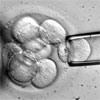
An interdisciplinary group of Harvard scientists stumbled across a new mechanism involved in the reprogramming of stem cells that could help "fine tune" induced pluripotent stem cells into specific cell types.
The researchers, variously affiliated with the Harvard Stem Cell Institute, the Broad Institute of Harvard and MIT, Harvard’s Department of Stem Cell and Regenerative Biology, Children’s Hospital Boston and Beth Israel Deaconess Medical Center, identified a set of genetic elements called lincRNAs.
"This is the first time that this new type of gene has been implicated in the reprogramming process," co-author John Rinn said in prepared remarks "This finding gives us another set of fingers to play on the genomic piano that controls the ‘music’ of cellular reprogramming."
"We know reprogramming resets the genome [of the reprogrammed cell] globally," added co-author George Daley of HSCI and Children’s Hospital. “What we’ve learned by working with John is that lincRNAs play essential roles in the reprogramming process. We’ve even identified one lincRNA that enhances reprogramming, which is tantalizing evidence that we can make reprogramming more efficient by harnessing lincRNAs. Our groups came together to answer a question that neither group could answer alone."
In September, another team of Harvard researchers announced the discovery of a way to reprogram human skin cells so that they become stem cells, bypassing the creation of stem cell lines from human embryos. The latest discovery, published online by Nature Genetics, could hold a clue about why that method works and could also be used to refine that technique.
"We started out looking for something else: We wanted to know what happens when you program skin cells that originate in different parts of the body into stem cells," Rinn said. "George and I were on a committee meeting together with a student who didn’t know the anatomic origin of the skin cells used to make stem cells. A light bulb went off that it may be interesting to make stem cells from skin cells originating all around the body and see if they ‘remember’ where they came from. Sabine Loewer, the lead author on the paper, immediately jumped at the idea as well — which was very brave for such a risky project.
"It turned out they didn’t matter where the cells came from, which is in itself an important finding. But in the process we found that hundreds of lincRNA genes were turned on and off during the reprogramming, so we focused on the ones that turned on, to see if they were part of the pluripotency process, and they were," Rinn said.

